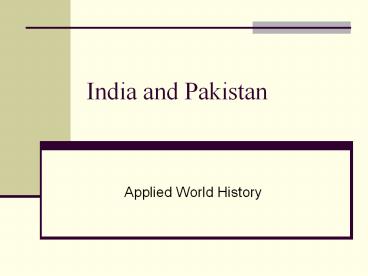India and Pakistan - PowerPoint PPT Presentation
1 / 15
Title:
India and Pakistan
Description:
India and Pakistan Applied World History – PowerPoint PPT presentation
Number of Views:265
Avg rating:3.0/5.0
Title: India and Pakistan
1
India and Pakistan
- Applied World History
2
The Indian Caste System
- For hundreds of years, a caste system existed in
India. It is based in the Hindu religion. - The highest class is the Brahman, or priestly
class. - Then comes the Kshatriya, or warrior and ruling
class. - Next are the Vaisha, or traders and merchants.
- Then comes the Sudra, or worker / farmers.
- Outside of the caste system is the group called
the untouchables.
3
How did the Caste System Work?
- You were born into the caste of your parents and
could never leave go up or down. - Hindus believe in reincarnation. They believed
that if they lived a good life, they could be
born into a higher caste. - Your caste dictates your spouse, choice of
career, and many other aspects of your life. - The Untouchables were outside of this system, and
those in higher castes believed that if they came
into contact with an Untouchable they had to
purify themselves.
4
India in the Early 20th Century
- India had been ruled over as a colony by the
British since the mid 1800s. - We have already talked about resentment towards
the British and the Sepoy Rebellion. - In 1919, this resentment grew because of the
Amritsar Massacre. - 400 unarmed Indians were killed at a peaceful
protest. - Indians were determined to rule themselves.
5
Mohandas Gandhi Emerges
- Gandhi takes control of the Indian National
Congress, which called for Indian Independence in
1914. - He tried to unite all Indians, regardless of
religious or ethnic background. - He led nonviolent protests that drew the worlds
attentions.
6
Gandhi Practices Non-Violence
- Gandhi preached the Hindu practice of Ahimsa, or
nonviolence and reverence of all living things. - He practiced civil disobedience, or the practice
of refusing to obey unjust laws. - He also argued for equal treatment for all
Indians, including Untouchables.
7
Gandhi Leads Non-Violent Protests
- Gandhi called for boycotts of British products,
especially textiles. - He used the spinning wheel and traditional Indian
industry as a symbol and rallying point. - His nonviolent protests drew mass support
throughout India and the world.
8
The Salt March
- Gandhi took a stand against the salt monopoly in
India. - Salt was readily available in the sea, but
Indians were forced to buy it from the British. - Gandhi set out in 1930 marching towards the sea
with 78 followers. - When he arrived, numbers were in the thousands.
- He picked up sea salt and was arrested.
- Other villages followed his lead.
9
The Response to the Salt March
- Gandhi was quickly arrested.
- Tens of thousands of Indians who followed his
lead were imprisoned as well. - The British reaction was criticized by
governments and individuals around the world.
10
India After World War II
- After World War II, Britain decided that it could
no longer control India. - However, the question arose about what would
happen to the Muslim minority in India. - Violence was spiraling out of control between the
Hindus and the Muslims of India.
11
Two New Countries are Created.
- In 1947, two new countries are created.
- The area of India that had been primarily Hindu
becomes India and the area that was primarily
Islamic became Pakistan. - As soon as the new border became known, huge
numbers of people began to migrate.
12
Refugees and Violence
- Millions of Muslims in the new India began to
flee to Pakistan. - Millions of Hindus in the new Pakistan began to
flee to India. - These people lost all of their property.
- This movement led to violence and over a million
people were killed. - Many others died of starvation or exposure on the
road.
13
Problems Early
- Soon after the independence of these two
countries, Gandhi is assassinated. - The two countries also go to war over a border
province called Kashmir. They will go to war
over it again in 1965 and will continue to
skirmish over it to the present day.
14
Problems Today
- Pakistan and India still do not get along.
- They still skirmish regularly over Kashmir.
- Since 1998, they have each had nuclear weapons.
This is clearly not a good thing. - Pakistan also shares a border with Afghanistan.
15
Pakistan and the War on Terror
- Pakistan shares a border with Afghanistan today.
- Many Taliban fighters and possibly al Qaeda
members are hiding in these mountains. - The government of Pakistan supports the US but
problems continue in this region.

